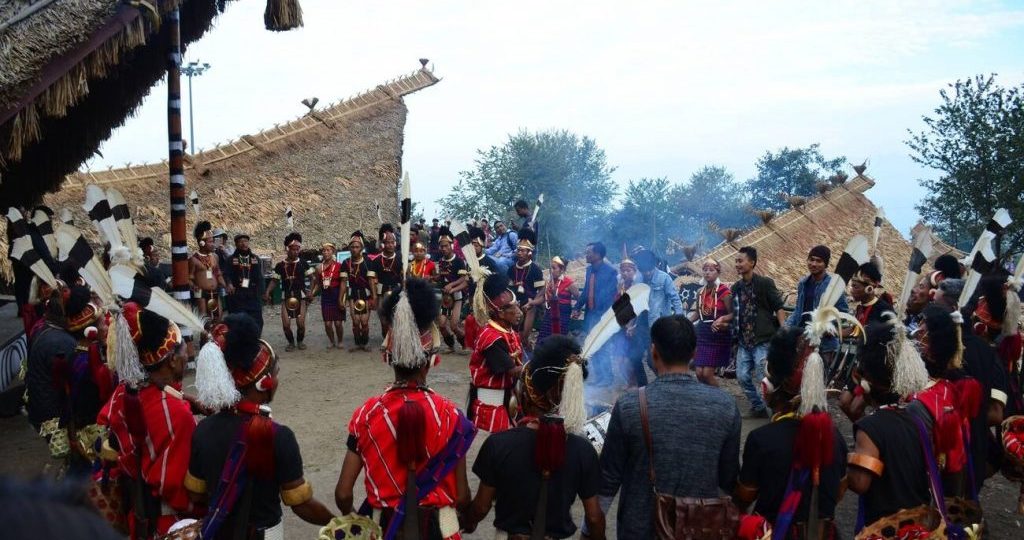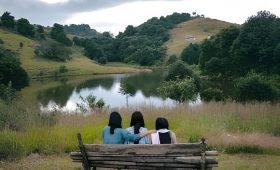Welcome to the Complete Guide to Hornbill Festival, Nagaland’s most iconic cultural extravaganza. Held annually from December 1-10, this vibrant festival showcases the rich heritage and traditions of Nagaland’s 16 indigenous tribes.
The Hornbill Festival Nagaland has its roots in the traditional Naga hospitality, where guests were welcomed with a ceremonial feast, music, and dance. In 2000, the Government of Nagaland launched the Hornbill Festival to promote unity, showcase cultural diversity, and boost tourism. Since then, it has grown into a spectacular event, attracting visitors from around the world.
The festival derives its name from the Indian hornbill, a revered bird in Naga culture, symbolizing prosperity and good fortune. The event takes place at the Naga Heritage Village, Kisama, which replicates a traditional Naga village. Over 10 days, the festival comes alive with:
– Colorful traditional attire
– Mesmerizing music and dance performances
– Delicious local cuisine
– Handicraft exhibitions
– Traditional sports and games
– Cultural competitions
This Complete Guide to Hornbill Festival will take you through the history, highlights, and experiences of this incredible event. Get ready to immerse yourself in Nagaland’s vibrant culture.
In this Complete Guide to Hornbill Festival, we’ll explore the festival’s significance, must-see attractions, and insider tips to make your experience unforgettable.
Tips to visit Hornbill Festival 2025:
Preparing for the Hornbill Festival 2024? Here’s your Complete Guide to Hornbill Festival:
Pre-Trip Planning-
1. Dates: December 1st -10th, 2025
These dates mark the celebration of the Hornbill Festival, often called the “Festival of Festivals” in Nagaland. Held annually, this 10-day event showcases the rich heritage, culture, and traditions of the Naga tribes. Set in the scenic Naga Heritage Village of Kisama, the festival attracts visitors from across India and beyond.
For those planning to attend, booking flights and accommodations early is essential due to the high inflow of tourists. From cultural performances, traditional dances, and songs to local cuisine and crafts, the festival offers an immersive experience into the diverse Naga culture. Travelers should plan their itinerary around these dates, keeping in mind any additional local sightseeing or visits to nearby villages. December weather in Nagaland is cool, making it a pleasant time to explore both the festival and the natural beauty of the region.
2. Venue: Naga Heritage Village, Kisama
Naga Heritage Village, located near Kohima, is the heart of the Hornbill Festival. The venue is a cultural crossing, designed to represent the architecture and living styles of the various Naga tribes. Each tribe has its own morung (dormitory), where they display traditional artifacts, handicrafts, and performances, offering visitors a chance to learn about their unique ways of life.
Set against the backdrop of lush green hills, the venue provides an authentic environment for showcasing Naga traditions. Kisama is around 12 kilometers from Kohima, the capital of Nagaland, making it easily accessible for tourists. Visitors should plan their transportation in advance, as traffic can get busy during the festival days. The serene surroundings and cultural richness make Naga Heritage Village an ideal venue to dive deep into the history and lifestyle of the Naga people.
3. Book flights to Dimapur Airport (DMU)
Dimapur Airport (DMU) is the nearest airport to Kohima and serves as the main gateway for visitors traveling to the Hornbill Festival. Situated about 75 kilometers from Kohima, Dimapur is well-connected to major Indian cities like Kolkata, Delhi, and Guwahati through direct flights. Travelers should book their flights in advance, as December sees a surge in air traffic due to the festival.
4. Arrange accommodation in Kohima or nearby areas
Accommodation options in Kohima, especially during the Hornbill Festival, can fill up quickly. Hotels, homestays, and guesthouses in Kohima offer a range of choices to suit different budgets, but it’s crucial to make bookings well in advance. For a more immersive experience, some travellers opt to stay in nearby villages where they can interact closely with locals and experience Naga hospitality firsthand. Kisama, being close to Kohima, also has some stay options but these may be limited. Staying near the festival venue ensures easy access and minimizes travel time, allowing visitors to fully enjoy the day-long events. Travelers should also be mindful of the cold December weather and choose accommodations that provide adequate heating facilities.

Travel Essentials
1. Vaccination Certificates (if required)
Depending on global health conditions, vaccination requirements may be in place for travelers to India. While there are no mandatory vaccinations for visiting Nagaland specifically, travelers should be up to date with routine vaccines. During pandemic times, COVID-19 vaccination certificates may also be required for entry into India, so it’s important to stay updated on government guidelines. Carry digital and printed copies of your vaccination certificates for easy reference at checkpoints.
2. Travel Insurance
Purchasing travel insurance is highly recommended for anyone attending the Hornbill Festival as well as wherever you travel around the globe. It covers unforeseen events such as medical emergencies, flight cancellations, lost luggage, or accidents. Some policies also offer coverage for adventure activities, which could be useful if you plan to explore Nagaland beyond the festival. Ensure your travel insurance policy includes coverage for trip delays and cancellations, especially considering the remote nature of the festival location, where unpredictable weather could impact travel plans. Read the policy carefully to understand its terms, coverage limits, and claims process.
3. Comfortable Clothing and Shoes
Nagaland in December can be quite chilly, especially in the mornings and evenings, so packing warm, layered clothing is important. A combination of thermals, sweaters, and jackets will keep you comfortable during the festival. Since the festival involves a lot of walking around the Naga Heritage Village, comfortable shoes are a must. The terrain can be uneven, and there’s a lot of ground to cover while exploring the various tribal exhibits and attending performances. Pack woolen caps, scarves, and gloves to stay warm, and carry a raincoat or an umbrella in case of unexpected showers. Being well-prepared clothing-wise will ensure you can fully enjoy the festival without discomfort.
Festival Tips to follow or keep in mind
1. Plan Ahead for Tickets and Accommodations
The Hornbill Festival is a major cultural event that attracts thousands of tourists each year. Securing tickets and accommodations well in advance is essential, as both tend to sell out quickly. Festival passes are typically available online and at the venue, but booking ahead ensures you won’t miss out. Accommodations in Kohima and nearby areas fill up fast during the festival, so making reservations several months before your trip is highly recommended. Whether you prefer hotels, guesthouses, or homestays, early booking gives you the best options at reasonable rates. Be sure to confirm all bookings and keep records of your reservations for a smooth experience.
2. Familiarize Yourself with Naga Culture and Traditions
The Hornbill Festival is a celebration of Naga culture, with each of the 16 major Naga tribes showcasing their unique traditions through performances, crafts, and food. Taking the time to learn about these diverse tribal cultures beforehand will enhance your experience. Understanding their history, customs, and values will allow you to appreciate the festival more deeply and engage meaningfully with locals. You can read about the significance of the hornbill bird in Naga folklore, explore tribal dances and songs online, or watch documentaries on Naga life. Being well-informed will also help you respect and navigate the cultural nuances you’ll encounter during your visit.
3. Respect Local Customs and Dress Modestly
While attending the Hornbill Festival, it’s important to be respectful of the local customs and dress codes. Nagaland is a culturally rich and diverse state with strong traditional values. Dressing modestly, and being adapting will show respect for the local community. Additionally, some tribal ceremonies or performances may have specific rules, such as prohibitions on photography or participation, which should be followed diligently. Showing curiosity and interest in the culture while remaining respectful will help build positive interactions with the locals and enrich your overall experience of the festival.
4. Bring Sunscreen, Hats, and Water
While the weather in Nagaland in December is generally cool, the sun can still be harsh during the day, especially when attending outdoor events at the Hornbill Festival. Carrying sunscreen will help protect your skin from sunburn, while a hat or cap can provide extra shade. Staying hydrated is also crucial, as the festival involves long hours outdoors and a lot of walking around the venue. Bringing a refillable water bottle will keep you hydrated without relying on bottled water. These small but important essentials will help you stay comfortable and energized while you explore all the festival has to offer.
Complete Guide to Hornbill Festival, consider:
– Weather: Cool winters (10-20°C)
– Language: English, Nagamese, and local dialects
– Currency: Indian Rupee
Packing List-
Warm clothing- Packing warm clothing is essential for attending the Hornbill Festival, as temperatures in December range from 10°C to 20°C. Layered clothing, such as thermal wear, sweaters, and jackets, will keep you comfortable throughout the day. As evenings tend to be colder, it’s also important to bring woolen caps, scarves, and gloves. Dressing in layers allows flexibility, as you can adjust according to the changing weather. Warm, cozy clothing will ensure you stay comfortable while enjoying outdoor events and performances at the festival.
Power adapter- A universal power adapter is a must-have when traveling to Nagaland, especially for international visitors. This will ensure that you can charge your electronic devices like phones, cameras, and laptops without any hassle. A power adapter is particularly important for those staying in homestays or guesthouses where power outlets may vary. Having one ensures smooth access to power during your trip.
Camera-Bringing a camera to the Hornbill Festival is essential for capturing the vibrant cultural displays, traditional dances, and scenic landscapes of Nagaland. Whether you prefer a DSLR, mirrorless camera, or even a high-quality smartphone, it’s important to document your experience at this colorful event. With so many unique performances and handicrafts on display, having a camera ensures you can preserve those special moments. Additionally, remember to carry extra memory cards and ensure your camera is fully charged for long festival days filled with photo opportunities.
Rechargeable batteries – Rechargeable batteries are a smart addition to your packing list, especially if you plan to take lots of photos or use other battery-powered devices during the Hornbill Festival. Since you may be exploring the festival all day, having spare, charged batteries will ensure your camera, flash, or other gadgets remain powered. Rechargeable batteries are also eco-friendly, reducing the need for disposable ones. Bring a charger for your batteries, and be sure to charge them overnight, so you’re always prepared to capture the festival’s lively moments.
Water bottle- A reusable water bottle is essential when attending the Hornbill Festival, as it allows you to stay hydrated throughout the day. The festival involves a lot of walking, and dehydration can easily occur, even in the cool December weather. Carrying your own water bottle ensures you have access to clean water without relying on single-use plastic bottles, making it an eco-friendly choice. Look for refill stations at the venue or carry water from your accommodation, and opt for an insulated bottle to keep your water cool or warm.
Complete Guide to Hornbill Festival, stay updated:
– Follow official Hornbill Festival social media
– Download festival schedules and maps
– Register for cultural events and workshops
Venture on an unforgettable journey to Nagaland with this Complete Guide to Hornbill Festival. Get ready to immerse yourself in rich Naga culture!
Things to do in Kisama village
Kisama Village, Nagaland’s cultural hub, offers a unique experience during the Hornbill Festival. Here are things to do:
Explore Naga Heritage Village
– Visit replica tribal huts to experience the traditional lifestyles of Nagaland’s various tribes.
– Discover traditional farming practices, showcasing how Naga communities have sustainably cultivated crops for generations.
– Learn about Naga architecture by observing the unique designs and construction techniques of the huts, which reflect each tribe’s identity and environment.
Cultural Experiences
– Attend traditional music and dance performances, featuring colorful costumes and rhythmic folk songs.
– Watch exciting Naga wrestling and archery competitions, showcasing local strength and skills.
– Participate in cultural workshops to engage directly with artisans, learning crafts like weaving, pottery, and beadwork.
Shopping and Food
– Browse handicraft stalls for unique local artifacts, including handwoven textiles, jewelry, and bamboo products.
– Savor traditional Naga cuisine, known for its use of bamboo shoots, smoked meat, and flavorful spices.
– Try local beverages like rice beer, a staple drink brewed during festivals and important occasions.
Festival Highlights
– Experience the opening ceremony, featuring a traditional procession of all Naga tribes in their vibrant attire.
– Enjoy the Hornbill National Dance Competition, showcasing a variety of tribal dance forms.
– Attend music festivals featuring performances by both local and international artists, celebrating the fusion of modern and traditional music.
Outdoor Activities
– Trek to nearby hills for breathtaking panoramic views of the surrounding landscapes and mountains.
– Explore surrounding forests and villages, immersing yourself in Nagaland’s natural beauty and rural life.
– Visit nearby Morungs, the traditional boys’ dormitories, to learn about their significance in Naga tribal culture.
Insider Tips
– Arrive early to avoid crowds
– Respect local customs and traditions
– Engage with locals to learn more about Naga culture
Duration: 2-3 days
Best Time: December 1-10 (Hornbill Festival)
Getting There: 12 km from Kohima, Nagaland’s capital
Engage yourself in Naga culture and traditions at Kisama Village, the heart of the Hornbill Festival.
Food and cuisine to try
Savor the flavors of Nagaland at the Hornbill Festival! Must-try dishes:

Traditional Naga Cuisine-
1. Smoked pork with fermented soya bean
2. Akhuni (fermented soybean paste) with rice
3. Galho (rice beer-based dish)
4. Zutho (rice beer)
5. Mithun (buffalo) meat
Local Delicacies-
1. Naga chili chicken
2. Fermented fish with vegetables
3. Steamed bamboo shoots
4. Tree tomato chutney
5. Nagaland-style momos
Street Food-
1. Grilled meat skewers
2. Fried yams and sweet potatoes
3. Boiled corn on the cob
4. Fresh fruit salads
5. Local tea and coffee
Desserts-
1. Rice cake with honey
2. Coconut laddu
3. Fruit salads with local honey
Indulge in these unique flavours and experience Nagaland’s culinary richness!
Enjoying Hornbill Festival 2025 Responsibly
To make the most of your Hornbill Festival experience while respecting the local culture and environment, follow these guidelines:
Respect Local Culture-
– Dress modestly, avoiding revealing clothing
– Remove shoes when entering tribal huts or morungs
– Avoid public displays of affection
– Respect traditional rituals and ceremonies
By being mindful of these cultural norms, you’ll demonstrate your appreciation for Nagaland’s rich heritage.
Environmental Conservation and Personal Safety-
To minimize your impact on the environment and ensure a safe experience:
– Carry reusable water bottles and bags
– Avoid single-use plastics
– Dispose waste properly
– Conserve energy and water
– Stay hydrated and bring sunscreen
– Avoid traveling alone at night
– Keep valuables secure
Support Local Communities and Sustainable Tourism-
To contribute to the local economy and promote sustainable tourism:

– Buy handicrafts and local products
– Eat at local food stalls and restaurants
– Hire local guides and transportation
– Support eco-friendly accommodations
– Research and learn about Naga culture
– Respect local traditions and customs
Additional Tips-
– Follow festival schedules and maps
– Stay informed about weather updates
– Bring necessary medications
– Respect festival organizers and volunteers
By embracing these responsible tourism practices, you’ll help preserve Nagaland’s unique culture and environment for future generations. Let’s celebrate Hornbill Festival 2024 responsibly!
More about Hornbill Festival 2025-
Get ready for Nagaland’s largest cultural extravaganza, the Hornbill Festival 2024. This 10-day festivity showcases the state’s rich heritage, from December 1-10. Our Complete Guide to Hornbill Festival provides insider tips and essential information.
Experience:
– Traditional music and dance performances
– Local cuisine and handicrafts
– Naga wrestling and archery competitions
– Cultural workshops and exhibitions
Plan your trip with our Complete Guide to Hornbill Festival and discover:
– Accommodation options
– Transportation guides
– Festival schedules
– Offbeat attractions
Get yourself in Nagaland’s vibrant culture and make unforgettable memories at Hornbill Festival 2025.




Hello there! This article could not be written any better!
Looking at this post reminds me of my previous roommate! He constantly kept talking about this.
I’ll send this article to him. Fairly certain he’ll have a very good read.
Many thanks for sharing!